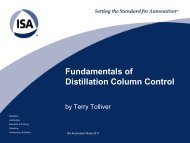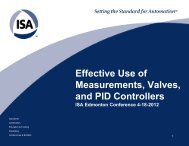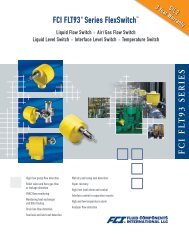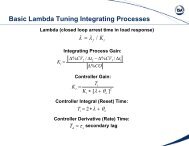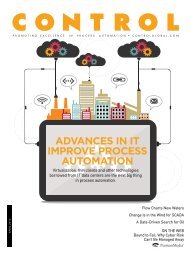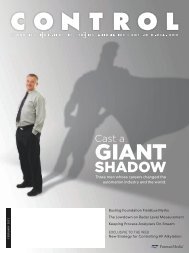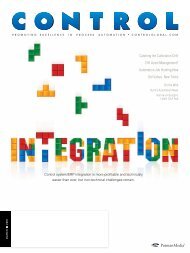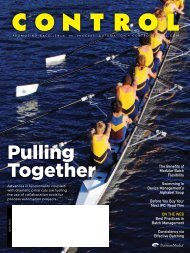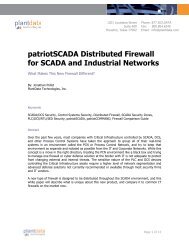April 2011 - Control Global
April 2011 - Control Global
April 2011 - Control Global
You also want an ePaper? Increase the reach of your titles
YUMPU automatically turns print PDFs into web optimized ePapers that Google loves.
a s k t h e e x p e r t S<br />
cations state if the sensors were individually tested (or only<br />
sampled), and state that the drift was measured, say, “for a<br />
period of X hours and was found to be Y% of output span.”<br />
Also. as I have illustrated in Figure 1, the total error (inaccuracy)<br />
of a measurement is the sum of its systematic and its<br />
random errors.<br />
The error caused by drift (some also call it shift), illustrated<br />
in Figure 2, is the difference between the specified<br />
and the actual performance of a sensor over a time period.<br />
The total drift error is the sum of two error components: the<br />
zero and the span shifts over some time period. When running<br />
a test to determine these values, one has to be careful<br />
to evaluate the whole system, not only the transmitter electronics.<br />
Let me illustrate that point by a recent experience:<br />
In connection with a lawsuit I, as an expert witness, was<br />
asked to evaluate the performance of a flow loop that was<br />
periodically calibrated only by checking the electronics of<br />
the transmitter using a simulator (not the actual signal from<br />
the sensor). Based on the simulated input signal to the analog<br />
transmitter (the secondary), the calibration appeared to<br />
be fine; the transmitter was generating a 4-mA output when<br />
the simulated input corresponded to a zero flow signal, and<br />
20 mA at a simulated 100% measurement signal. Yet, while<br />
the transmitter correctly measured the simulated input signal,<br />
the actual signal from the sensor (because of zero and<br />
the span shift) has drifted so much over the decades of uncalibrated<br />
operation of the primary that the total system error<br />
amounted to 50% when the flow averaged about 20% of<br />
span. (Naturally, as shown in Figure 2, this error percentage<br />
becomes a smaller fraction of the total flow.)<br />
Therefore, the evaluation of the drift should also be based<br />
on testing the primary and the secondary together using the<br />
actual measurement signal and not a simulated one.<br />
Stability is a more general term, as it can include not only<br />
drift (which is a function of the passage of time), but also<br />
the environmental effects (pressure, temperature, humidity,<br />
vibration), process effects (coating, corrosion, aging) and<br />
other factors, such as cycling, hysteresis, linearity, noise, etc.<br />
Offset (some also call it droop) is a term used in connection<br />
with proportional-only controllers because such devices<br />
(thermostats, pressure regulators, etc.) start making a correction<br />
only after an error has already developed. The amount<br />
of offset rises as the gain of the controller drops (proportional<br />
band increases).<br />
Bias occurs when a constant amount is added to or subtracted<br />
from a signal. For example, zero shift can bias the<br />
output of a sensor. A positive bias of a sensor output results<br />
in over- reporting and a negative bias in underreporting the<br />
variable measured.<br />
Béla Lipták<br />
liptakbela@aol.com<br />
100<br />
% Output y<br />
0<br />
0 % Input x<br />
100<br />
the drift test<br />
Actual calibration curve<br />
Figure 2. The results of a drift test should state the time period of<br />
testing and should report the errors caused by both the zero and<br />
the span shift that was measured at the end of that period over the<br />
full range (span) of the sensor.<br />
Q<br />
I read your article on steam quality measurement<br />
with great interest. I am working in a thermal project<br />
pilot plant and would like to measure the steam<br />
quality at the injection well where the line size is 3 ins.<br />
Can you give me some information on “throttling calorimeters”?<br />
Also please recommend a steam quality measurement<br />
device that is not cumbersome to measure SQ in the<br />
3-in. line.<br />
Vijay Ramlal<br />
VRamlal@kockw.com<br />
A<br />
Standard technique in large power plants in the United<br />
States to assure steam quality on super heated steam is<br />
to measure sodium ion concentration, usually in ppb<br />
in two or more locations. Particular attention should be paid<br />
to obtain representative samples before and after the mud<br />
flow cycle. Several companies offer products, but sample<br />
conditioning is difficult. After several manufacturers’ trial<br />
application, I found one English company’s product to be<br />
easy to maintain and reliable. You can write to me directly if<br />
you need more information.<br />
Ram.G.Ramachandran<br />
ramacg@cox.net<br />
Specified characteristic curve<br />
Span<br />
Span shift<br />
Zero shift<br />
Elevation<br />
A p r i l / 2 0 1 1 www.controlglobal.com 53



